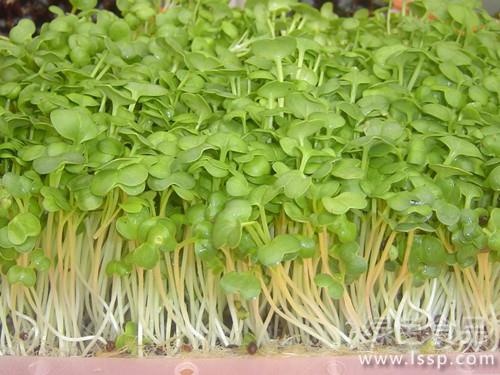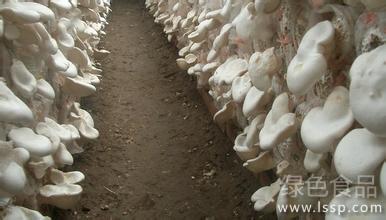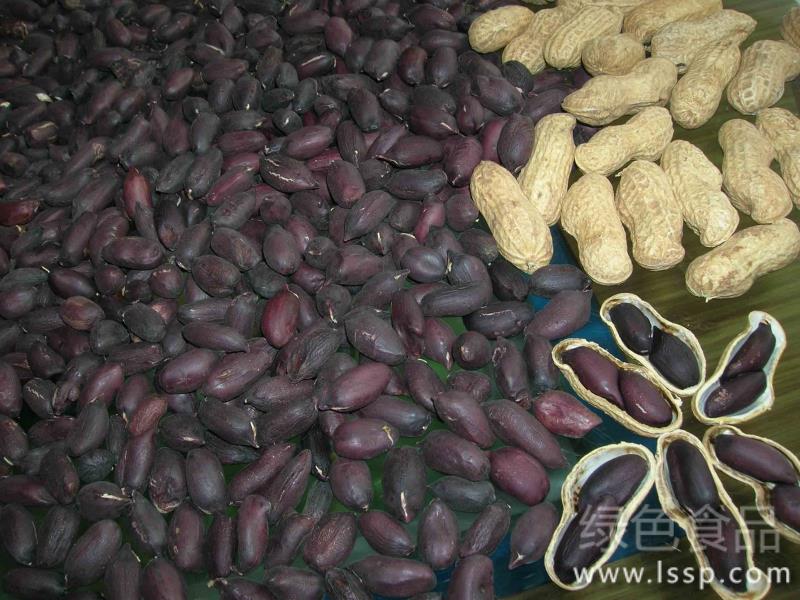High-yielding cultivation techniques of fresh and tender vegetable radish sprouts

Radish sprouts
Radish sprouts are fat and tender seedlings that germinate and grow after radish sowing. This kind of vegetable is of fresh and tender quality, unique flavor, rich in vitamins, calcium, phosphorus and so on. It can be used as soup or salad. It is a kind of seasonal vegetable that everyone likes. The main points of cultivation are as follows.
Radish sprouts like warm and humid, not resistant to drought and high temperature, light requirements are not strict. When the temperature is suitable, the Hypocotyl length of 5 cm can be harvested 7-10 days after sowing. Protected areas such as open fields or plastic greenhouses can be planted, or they can be cultivated with soil and nutrient solution.
The main results are as follows: (1) the seeds of general radish varieties can be used, but the epidermis green radish seeds are better. The production of radish sprouts should choose full seeds, such as big green radish, Chuanxinhong, full garden flower seed, green fat radish and so on. There are also special varieties such as Fuye 40-day radish introduced from Japan for cultivation at high temperature, Osaka 4010 radish cultivated at medium and low temperature, ideal 40-day radish and so on. Seeds are required to be free of sand, sclerotia and other impurities. after screening sundries and unfull seeds, rinse radish seeds with water for 2 or 3 times to remove dirt and sundries outside the seed coat.
(2) sowing the seeds at 20 ℃ water temperature, soaking the seeds for 2 hours and washing them with clean water for 2 times to make the seeds absorb enough water. Radish sprouts can grow at 5: 35 ℃, and the optimum temperature is 20: 25 ℃. The culture plate should be washed clean before sowing, and the plate with large mesh and leaking seeds should be covered with a layer of clean wet white paper, and then spread the seeds evenly on it. The sowing density is suitable for non-overlapping seeds.
(3) shading should be carried out after broadcasting to maintain a dark environment. Therefore, after sowing, you can stack plates, such as every 5 plates into a pile, and then buckle an empty plate at the top. Cover the empty plate with wet sacks to moisturize. Three days before harvest, the cotyledons were gradually visible, and the cotyledons were green to ensure that the Hypocotyl was upright and white, and the quality was improved. Specific operation can be sown, sprinkle water every morning, 2-3 days later, the radicle can grow to about 2 cm. At this time, the plates should be placed separately, and an empty plate should be buckled on each plate to block the light and moisturize. After 1-2 days, the Hypocotyl grew to 2-3 cm, remove the empty disk and increase the light. At the same time, sprinkle water once a day in the morning and evening to make the water saturated.
(4) 5-8 days after harvest and sowing, the cotyledons fully unfolded, the true leaves did not come out, the Hypocotyl was 4-6 cm long, and the fresh weight of 100 plants reached 8.5-10 kg. It is usually done when the dew is not dry in the morning or when the sun goes down in the evening. Radish sprouts generally turn yellow after 10 or 13 days and should be sold as soon as possible.
- Prev

Winter management methods to avoid affecting the mushroom bed harvested in the coming year
Winter management methods to avoid affecting the mushroom bed harvested in the coming year
- Next

Cultivation techniques of black peanut with special health care effect
Cultivation techniques of black peanut with special health care effect
Related
- Fuxing push coffee new agricultural production and marketing class: lack of small-scale processing plants
- Jujube rice field leisure farm deep ploughing Yilan for five years to create a space for organic food and play
- Nongyu Farm-A trial of organic papaya for brave women with advanced technology
- Four points for attention in the prevention and control of diseases and insect pests of edible fungi
- How to add nutrient solution to Edible Fungi
- Is there any good way to control edible fungus mites?
- Open Inoculation Technology of Edible Fungi
- Is there any clever way to use fertilizer for edible fungus in winter?
- What agents are used to kill the pathogens of edible fungi in the mushroom shed?
- Rapid drying of Edible Fungi

